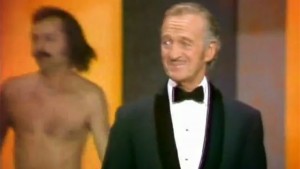One of the great bon-mots of popular cultural history occurred during the 1974 Academy Awards ceremony. David Niven was at the podium when a “streaker” (an inexplicable fad at the time was someone getting completely naked and running through a public forum) jogged across the stage.
The unflappable Niven calmly waited for the laughter to die down, and then remarked in his impeccable English accent, “Isn’t it fascinating to think that probably the only laugh that man will ever get in his life is by stripping off and showing his shortcomings.”
Thankfully, the streaking fad is kaput. But there are other places where shortcomings are wont to appear.
Some time ago veteran editor Alan Rinzler posted on Writer Unboxed about “issues” writers today are facing. While the post itself was solid, I was more intrigued by one of his comments. Rinzler was asked a question in the combox by none other than super agent Donald Maass. Don wanted to know what the #1 shortcoming Rinzler, as a developmental editor, saw in manuscripts. Rinzler’s answer was:
I see disorganized stories of excessive complexity… intrusive narrative voices that come between the reader and the story by inserting ongoing commentary, explanation, and interpretation…a failure to research and do the homework necessary to come up with something truly original and not reinvent the wheel… two-dimensional stereotype characterization…dialogue that all sounds like the same person.
I like this list. Let’s take a look at each item:
1. Disorganized stories of excessive complexity
I once picked up a bit of screenwriting wisdom that applies here. The best movies (and novels) consist of simple plots about complex characters. That is, while the plot may contain mystery and twists (and should), it is, at its core, a basic story with understandable motives. The real meat and originality comes from putting truly complex characters into those stories. The secret to originality can be found in the limitless interior landscape of human beings.
2. Intrusive narrative voices
Learning how to handle exposition, especially when to leave it out entirely, is one of the most important and early craft challenges. So get to it. Revision & Self-Editing for Publication has a whole section on this, but here’s one tip: place exposition seamlessly into confrontational dialogue. Instead of: Frank never wanted to have a baby. Not until he was a success as a writer. But Marilyn thought his quest was foolish. After all, it had been five years since he left his job at AIG. Marilyn dearly wanted him to try to get his job back.
“You never wanted a baby, Frank.”
“Shut up about that.”
“All because of your stupid writing obsession!”
“I’m not obsessed!”
“Oh really? What do you call five years of typing and no money to show for it?”
“Practice!”
“Well, practice time is over. Tomorrow you’re going to beg AIG to take you back.”
3. A failure to research . . . to come up with something truly original
Rinzler is talking about the concept stage here, which is foundational. Hard work on fresh concepts will pay off. And remember, freshness isn’t just a matter of something “unfamiliar.” All plot situations have been done. It’s how you dress them up and freshen them that makes the difference. Remember Die Hard? After it became a hit, we had Die Hard on a ship (Under Siege) and on a mountain (Cliffhanger)and so on. Take a standard rom-com about a writer struggling with writer’s block and set it in Elizabethan England and you get Shakespeare in Love. Heck, take an old dystopian cult plot like Deathrace 2000 and put it among kids and bingo, you’ve got The Hunger Games.
4. Two-dimensional characters
We all know that flat characters are a drag on an otherwise nice plot idea. Such a waste! As Lajos Egri put it in his classic, Creative Writing: “Living, vibrating human beings are still the secret and magic formula of great and enduring writing.”
My favorite book on characterization is Dynamic Characters by my former colleague at Writer’s Digest, Nancy Kress.
5. Dialogue that all sounds like the same person
Ah! One of my sweet spots. In my workshops I always say the fastest way to improve a manuscript is via dialogue. It’s also the fastest way to get an agent or editor to reject you, or readers to give you a yawn. When they see good, crisp dialogue, differentiated via character, it pops. It gives them confidence they’re dealing with someone who knows the craft.
The place to start, then, is by making sure every character in your cast is unique. I use a “voice journal” for each, a free-form document of the character just yakking at me, until I truly “hear” them in a singular fashion.
So there you have it. Five vital areas where shortcomings might be a problem. The streaking guy at the Oscars couldn’t do anything about his own vital area, but you as a writer can.
Anything you’d like to add to the list?

